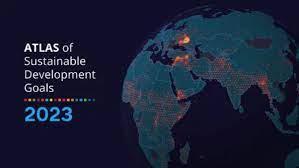
https://blogs.worldbank.org/developmenttalk/sdg-atlas-2023-five-key-find...
The 2023 Atlas of Sustainable Development Goals provides a comprehensive overview of the progress made towards achieving the SDGs. The report highlights critical findings that are essential to understanding the current state of the world and the challenges that lie ahead. Below are a few we found particularly impactful.
1. COVID-19 Vaccines Have Saved Many Lives
The development of and access to safe and effective vaccines is essential in the fight against many communicable diseases. The COVID-19 pandemic has had a devastating impact, with millions of people losing their lives. However, the development of new vaccines has been a game-changer in the fight against the virus. These vaccines have been effective in reducing serious illness and death and are the first line of defense against the disease caused by the virus. A Lancet study shows that during the first year of immunization against COVID-19 (December 2020 to December 2021), vaccinations prevented at least 14.4 million deaths globally. This highlights the importance of vaccination programs in saving lives and reducing the impact of the pandemic. How your country did? Look at this chart
2. One in Five Girls Still Get Married Before They Turn 18
Child marriage remains prevalent in many countries. This has detrimental effects on girls’ health and economic well-being, depriving them of their basic human rights. Child marriage contributes to a higher prevalence of adolescent pregnancy and childbirth, resulting in increased health risks for young girls. It also limits their educational opportunities and exposes them to a higher risk of domestic violence. In 20 of the 121 countries with available data, at least one in every 10 women were married by the age of 15. The prevalence of child marriage varies across countries and cultures, often driven by factors such as poverty and limited access to education. Climate change can further exacerbate this issue, as families facing a significant loss of income may resort to various coping mechanisms, including increased work, selling assets, withdrawing children from school, and even resorting to early marriages. What is the situation in your country?
3. In Most Countries, Per Capita Water Resources Have Been Steadily Decreasing
Access to clean water has increased in recent decades, but global freshwater withdrawal is estimated to have more than doubled since 1960. Economic development and population growth have put pressure on freshwater resources, and climate change represents an additional challenge as it is already impacting and will likely continue to affect the quality and quantity of water in many river basins. Since the 1960s, about two-thirds of countries have seen an increase in their level of water stress. It is therefore essential to monitor stress on water resources as an early warning indicator of potential scarcity
4. Since 2000, Forest Area the Size of Egypt has Disappeared Across the World
In 2020, forests accounted for almost a third of global land area. However, since 2000, forest area across the world has declined by 2.4 percent, a surface equivalent to the size of Egypt. Deforestation and forest degradation threaten the ability of forests to contribute to sustainable development. The global rate of deforestation has slowed but remains high, with most deforestation taking place in tropical regions. Given that tropical forests hold higher levels of carbon and provide habitat for more species than other types of forests, this loss is particularly detrimental to global CO2 emissions and to biodiversity.
5. Support for the World’s Poorest Countries was Lower Than Pre-Pandemic Levels
Progress toward the SDGs requires significant investment in programs, policies, human capital, and infrastructure. From 2019 to 2022, official development assistance saw a sharp increase due to the COVID-19 pandemic and the war in Ukraine. However, excluding these unique events, support for the world’s poorest countries was lower than pre-pandemic levels. Although official aid has reached a record high in absolute real terms, relative to the size of donor economies, aid remains short of targets, barely above half the target for developed nations to allocate at least 0.7 percent of GNI for aid to poorer countries, as specified in SDG target 17.2. To meet this target collectively, donor countries would have to almost double current aid levels.











